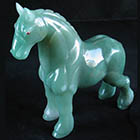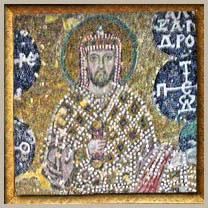Biographies - Peter Karl Fabergé
Peter Karl Fabergé, by Nick Nicholson
by Nicholas Nicholson
Peter Carl Fabergé was born in St. Petersburg in 1846 to French Huguenot parents. Fabergé's father, Gustav, had moved to Russia from France, and had been active as a jeweler in the capital since 1841. Gustav Fabergé specialized in the heavy and eclectic jewelry of the mid-nineteenth century which appealed so much to Russian buyers (though not, so much, as the French name of the maker).
In 1860, Carl accompanied his parents to Dresden. From there, Carl was sent on a grand tour of Paris, Florence, and Frankfurt -- all of them centers of jewelry production, and all of them with major collections of jewelry and jeweled objects dating from the Renaissance through the Eighteenth Century. Bu he time he returned to Russia, Fabergé was a certified master in jewelry production and history, and he joined his father's firm, working alongside August Holmstrom, and later, Erik Kollin. By 1872, Fabergé had taken over his father's firm, with Kollin as head workmaster.
It is in this period in which the firm begins it's rise. The period between 1866 to 1885 is a bit murky, as the firm produced "somewhat clumsy gold bracelets... fashionable at the time, brooches and medallions..." In this period, Fabergé was running in synch with other French jewelers of the time. But by the 1880s, everything would change.
In 1882, twenty-year old Agathon Fabergé (Carl's son) joined the firm. Now that the family had been residents in Russia for three generations, a specific "Russian Taste" which combined luxurious materials, complicated enamel colors and techniques, and the grammar of French ornament took hold. Mikhail Perchin was hired, and the Firm became at once fashionable and global.
The Imperial eggs, objets d'art, flat and hollow silver, and jewelry for which we know the firm today, was all produced in the period between 1885-1918. The firm of Fabergé eventually expanded to include shops in St. Petersburg, Moscow, Odessa, Kiev, and London. Trunk shows were regularly organized in Paris and in the watering holes of Nice, Baden-Baden, and other places of fashion. The firm broke new stylistic and technical ground still unequaled by contemporary jewelers. In 1910, in the culmination of Carl Fabergé's career, the House was given the distinction of "Jeweler to the Imperial Court".
In November 1918, the House of Fabergé closed forever. Agathon Fabergé was detained by the Soviet government to catalogue and value the nationalized jewelry treasures of the Russian Empire. On the 24th of September, 1920, Carl Fabergé died in exile at the Hotel Bellvue, La Rosiaz, Switzerland.
In 1929, Fabergé and his wife, Augusta were interred in the Russian cemetery at Cannes.
Please send your comments on this page and the Time Machine to the author - Nick Nicholson





 Imperial Bedroom
Imperial Bedroom Portrait Hall
Portrait Hall Mauve Room
Mauve Room Maple Room
Maple Room Aleksey's Bedroom
Aleksey's Bedroom Nicholas's Study
Nicholas's Study Aleksey's Playroom
Aleksey's Playroom Formal Reception
Formal Reception Balcony View
Balcony View Aleksey- Balcony
Aleksey- Balcony Children-Mauve
Children-Mauve Nicholas's Bathroom
Nicholas's Bathroom Alexandra- Mauve
Alexandra- Mauve Nicholas's Reception
Nicholas's Reception Tsarskoe Selo Map
Tsarskoe Selo Map